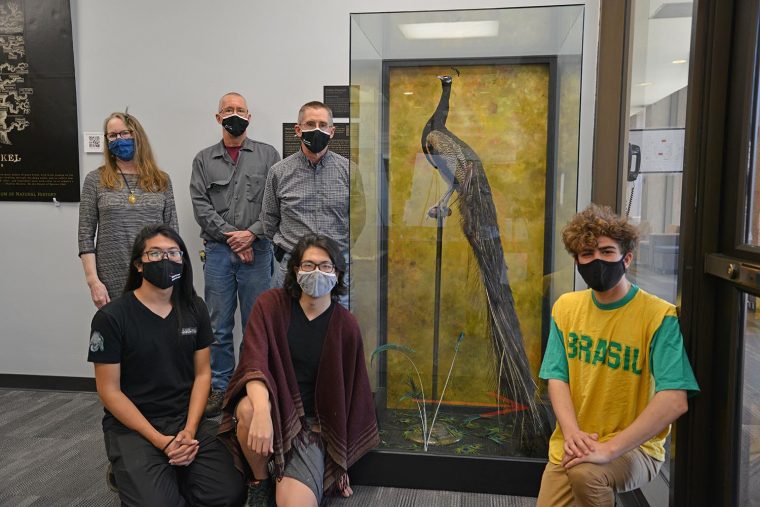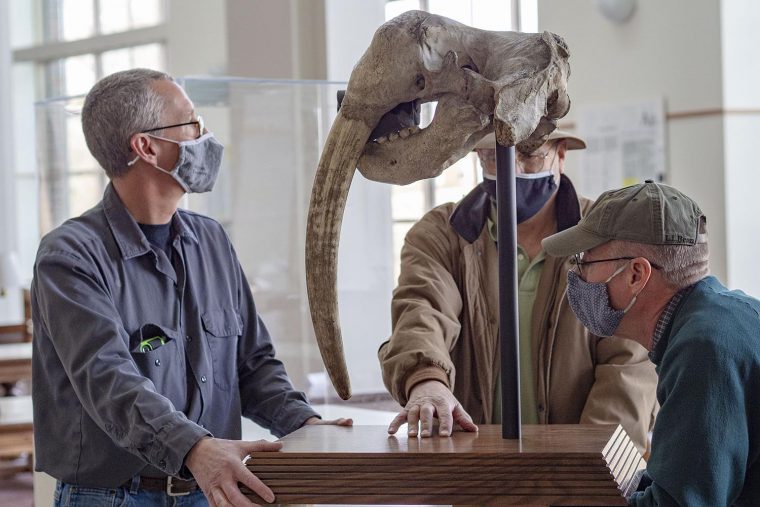The entrance to the Science Library in Exley Science Center houses a taxidermied peacock that has been restored by faculty and students in the biology department. The peacock, originally rediscovered in 2018 and put on exhibit in spring 2019, is part of a bird collection that was first displayed at the museum in Judd Hall and now belongs to the Wesleyan Museum of Natural History. The restoration team, which includes Professor of Biology Ann Campbell Burke, Yu Kai Tan BA/MA ’21, Andy Tan ’21, and Fletcher Levy ’23, recently updated the display to include new signage and fresh peacock feathers…
Olin Library's newest resident is looking for a good book to sink his tusk into. The skull of a one-toothed walrus, which was installed in the Campbell Reading Room on Jan. 20, is the University's latest exhibit on display from the former Museum of Wesleyan University (1871–1957). The piece was donated to Wesleyan 145 years ago by the Smithsonian National Museum of Natural History but has spent about half of its university life in storage. The 26-pound skull, which is missing its right tusk, belonged to a Pacific walrus (Odobenus rosmarus divergens) living along the Ugashik River in Alaska in…
Wesleyan students, graduate students, and recent alumni will present research posters during the annual Geological Society of America meeting Oct. 26–30. The virtual event will allow for a five-minute presentation followed by a five-minute period to answer questions. Earth and environmental sciences graduate student Yu Kai Tan '20 and Andy (Dick Yee) Tan '21 will present their poster, titled "Freshwater Mussels in North America: Museum Collections and Pre-Industrial Biogeography," at 5:15 p.m. Oct. 29. Their advisors are Ann Burke, professor of biology, and Ellen Thomas, Harold T. Stearns Professor of Integrative Sciences, Smith Curator of Paleontology of the Joe Webb…
As part of the University's efforts to "activate campus," a third prehistoric creature has taken up residence at Wesleyan. The new Mosasaur exhibit is on permanent display inside Olin Library and is a collaboration of faculty, student, and staff efforts. Mosasaurus hoffmannii Mantell (Mosasaur), a marine lizard, lived in the oceans during the Late Cretaceous period (66 to 68 million years ago) when the last dinosaurs walked the Earth. Mosasaurs had long, snake-like bodies with paddle-like limbs and flattened tails. Some specimens grew to be more than 50 feet long. In 1871, chemist Orange Judd of the Wesleyan Class of…
Ann Burke, professor of biology, spoke on “The origin and evolution of Turtles” during the 10th International Congress of Vertebrate Morphologlogy in Barcelona, Spain July 7- 12. The International Congress of Vertebrate Morphology (ICVM) has emerged as the premier conference for scientists researching the morphology of vertebrate animals at all levels of organization. The Congresses are held typically every three years with the broad goal of providing an opportunity for interaction, integration, and interfacing. Through a mixture of symposia, workshops, and open platform and poster sessions, everyone from senior scholars to students share ideas in an informal and genial setting. More…
A paper co-written by Professor of Biology Ann Burke, “Body wall development in lamprey and a new perspective on the origin of vertebrate paired fins,” was published in the July issue of the Proceedings of the National Academy of Sciences. Burke and her colleagues investigated the sea lamprey and the Japanese lamprey, comparing “the embryonic development of both these jawless fish to jawed animals — a shark, the catshark, and a salamander, the axolotl.” The abstract of the paper states, “Classical hypotheses regarding the evolutionary origin of paired appendages propose transformation of precursor structures (gill arches and lateral fin folds) into…
Professor of Biology Ann Burke recently completed a Fulbright Specialists project in Nepal at The Patan Academy of Health Sciences. It is the mission of this new medical program to train students from rural areas of Nepal who are committed to returning to their villages to provide desperately needed health care. Burke's project, which involved training local faculty in the teaching of human anatomy for medical students, was completed during the months of May and June. Burke was one of over 400 American faculty and professionals who will travel abroad this year through the Fulbright's Specialists Program. The program, created…
Wesleyan has announced the following promotions of faculty, effective July 1, 2010: Promotion with Tenure During the academic year, the Wesleyan Board of Trustees maintains an ongoing process of tenure case consideration. During its most recent review, the Board awarded tenure to one faculty member effective July 1, 2010. Michael Singer, associate professor of biology, was appointed assistant professor at Wesleyan in 2004. Previously he was postdoctoral fellow at the University of Arizona’s Center for Insect Science, in Tucson. Singer’s research examines the evolutionary ecology of tri-trophic interactions between plants, herbivores and carnivores. In considering (more…)
Ann Burke, professor of biology, received a $5,700 grant from the National Institutes of Health’s Eunice Kennedy Shriver National Institute of Child Health and Human Development, to support a symposium on “Evolution and Development in the Lateral Plate Mesoderm.” This symposium was part of the program of the Ninth International Congress of Vertebrate Morphology held July 26-31 in Punta del Esta, Uruguay. The funds supported the housing and registration costs for six invited speakers. The symposium brought together paleontologists, developmental and evolutionary biologists to discuss major morphological innovations occurring in the lateral plate mesoderm.
Ann Burke, associate professor of biology, recently received a three-year, $395,000 grant from the National Science Foundation (NSF) to study the development and evolution of the shoulder girdle using transgenic mice, frog and salamander. The mice will be generated in collaboration with a lab at the University of Michigan and will allow Burke and her associates to turn off Hox genes, which are specific patterning genes, in specific sub populations of the embryonic mesoderm that make the musculoskeletal tissues. "Comparing the dynamics of gene expression and cell interactions during the formation of the pectoral region in a variety of embryos…
Ann Burke, associate professor of biology, received a three-year, $395,000 grant from the National Science Foundation (NSF) to study the development and evolution of the shoulder girdle using transgenic mice, frog and salamander. She also received a two-year $100,000 grant from the National Institutes of Health (NIH) to use the same amphibian systems (salamander and frog) to develop a model system for understanding body wall defects in humans.The grants will provide funds for a team of researchers at Wesleyan working with Burke on these projects, including a postdoctoral fellow, graduate students and undergraduates.
Ann Burke, associate professor of biology, and Sonia Sultan, professor of biology, received individual grants from the Eppley foundation for research. The Eppley Foundation for Research supports advanced post-doctoral work in the physical and biological sciences, computer science, social sciences, and educational programs. Burke's grant, worth $32,442, will help to support her postdoctoral research fellow, Rebecca Shearman. Sultan's grant, worth $25,000, provides support while she writes a book.




